 |
 |
| Environmental Status |
| Marine environment |
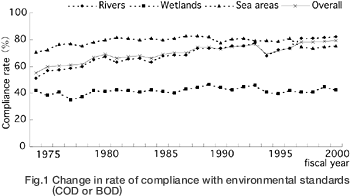 Water quality Water quality
Chemical Oxygen Demand (COD) is a representative water quality index for organic pollution. The COD compliance rate with the environmental standards remained constant around 80 % between 1980 and 1996. This was reduced to around 75% post 1997 and is probably due to the deterioration of the water quality around river mouths. |
 |
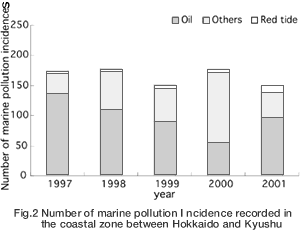 Marine pollution Marine pollution
According to the recent surveys of Japan Coast Guard 150-180 incidences of marine pollution occur annually and have been reported along the coast between Hokkaido and Kyushu. Oil pollution incidents are the most frequent form of marine pollution, however several red tides are also recorded every year. In 2000, high numbers of waste pollution were reported with 113 recorded incidences. |
 |
Status of coastline
Many parts of the coastline (intertidal areas) within the Sea of Japan region remain untouched and the proportion of natural coastline is 10-20% higher than compared to the national average. |
 |
| River environment |
Water quality
Biological Oxygen Demand (BOD) is a popular water quality index for organic pollution and its compliance rate with environmental standards has been constantly improving. Although the compliance rate momentarily decreased in 1994 due to persistent droughts, it has since recovered and in 1997 reached an 80% level (Fig. 1). |
 |
Status of sewage treatment
As of 1998, the percentage of sewered population in Japan stood at 58% but it was under 50% in many parts of the country. Especially, the Tohoku and Chugoku regions, both in the Northwest Pacific Region lag behind. |
 |
| Atmospheric environment |
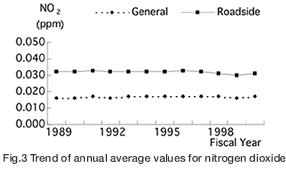 Nitrogen oxides (NOx) Nitrogen oxides (NOx)
The average NO2 concentration value in 2000 was 0.017ppm at the “ambient air pollution monitoring station (General) *1” and 0.031ppm at the “automobile exhaust gas monitoring station (Roadside) *2”, showing a slight increase from the previous year but no significant deviation from the long term trend (Fig. 3).
NO2 concentration in most of the region reached a 100% compliance rate with environmental standards although some “automobile exhaust gas monitoring station(s)” had only an 80% compliance rate. |
 |
Sulfur dioxides (SO2)
SO2 concentration is stable with a slight indication of a decreasing trend (Fig. 4). |
 |
Suspended particulate matter (SPM)
SPM concentration is stable and recently displays a decreasing trend (Fig. 5).
Although SPM concentrations in some areas of the region have low compliance rates compared to environmental standards most regions show a 90-100% compliance rate. |
 |
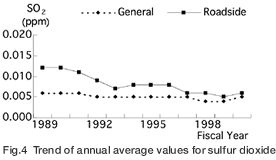 |
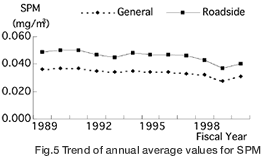 |
*1 : 24hr air pollution monitoring station, established in accordance with the “Air Pollution Control Law”
*2 : 24hr vehicle exhaust gas air pollution monitoring station, established in accordance with the “Air Pollution Control Law” |
 |
| Environmental Administration |
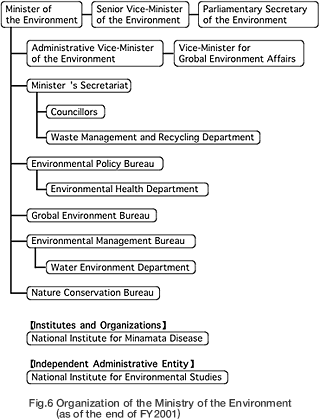 Administrative
structure Administrative
structure
The Ministry of the Environment plays a central role in the development and implementation of environmental policy of Japan. Its main tasks are protection of the global environment, prevention of pollution, protection and maintenance of the natural environment as well as various other environmental protection measures (including the creation of a favorable environment).
The Ministry of Economy, Trade and Industry, and The Ministry of Land, Infrastructure and Transport are also involved in various environmental programs working on issues such as global warming and vehicle pollution.
Environmental laws and regulations
“The Basic Environment Law” (enacted in 1993) and “The Natural Environment Conservation Law” (enacted in 1972) are the two fundamental environmental laws. “The Basic Environment Law” provides the basic national policy on environmental conservation and the “Natural Environment Conservation Law” provides the basic conservation policy for the natural environment of Japan.
Under the above laws, various air, water and soil quality laws are enacted (Table 1). |
 |
| Table 1 Major environmental laws |
| Category |
Laws |
| Basic Law |
– The Basic Environment Law (promulgated in 1993.11.19)
– Natural Environment Conservation Law (promulgated in 1972.6.22) |
Air
Noise and
Vibration |
– Air Pollution Control Law (promulgated in 1968.6.10)
– Law Concerning Special Measures for Total Emission Reduction of Nitrogen Oxides from Automobiles in Specified Areas (Automobile NOx Law) (promulgated in 2001.6.27)
– Law Concerning the Measures to Cope with Global Warming (promulgated in 1998.10.9)
– Law Concerning the Protection of the Ozone Layer Through the Control of Specified Substances and Other Measures (promulgated in 1988.5.20)
– Noise Regulation Law (promulgated in 1968.6.10
– Vibration Regulation Law (promulgated in 1976.6.10
– Offensive Odor Control Law (promulgated in 1971.6.1 |
| Water |
– Water Pollution Control Law (promulgated in 1970.12.25)
– Law Concerning Special Measures for Conservation of Lake Water Quality (promulgated in 1984.7.27)
– Law Concerning Special Measures for Conservation of the Environment of the Seto Inland Sea (promulgated in 1973.10.2) |
| Soil |
– Soil Contamination Countermeasures Law (promulgated in 2002.5.29)
– Agricultural Chemicals Regulation Law (promulgated in 1948.7.1)
– Agricultural Land Soil Pollution Prevention Law (promulgated in 1970.12.25)
– Industrial Water Law (promulgated in 1956.6.11)
– Law Concerning Regulation of Pumping-up of Groundwater for Building Use (promulgated in 1962.5.1) |
Waste
Recycle |
- Basic Law to Promote Formation of Circulating-type Society (promulgated in 2000.6.2)
- Waste Disposal and Public Cleansing Law (promulgated in 1970.12.25)
- Law for the Promotion of Utilization of Recycled Resources (promulgated in 1991.4.26)
- Law for the Promotion of Sorted Collection and Recycling of Containers and Packaging (promulgated in 1995.6.16)
- Law Concerning Recycling of Specific Household Electric Appliances (Household Electric Goods Recycle Law) (promulgated in 1998.6.5)
- Law Concerning Reuse of Resources of Material Relating to Construction Works (promulgated in 2000.5.31)
- Law Concerning Promotion of Reuse of Food Recycle Resources (promulgated in 2000.6.7)
- Law Concerning the Promotion of Procurement of Eco-Friendly Goods and Services by the State and Other Entities (Law on Promoting Green Purchasing) (promulgated in 2000.5.31) |
Natural
Resources |
- Nature Conservation Law (promulgated in 1972.6.22)
- Nature Parks Law (promulgated in 1957.6.1)
- National Strategy of Japan on Biological Diversity (adopted in 2002.3.27) |
| Others |
[Impact Assessment]
- Environmental Impact Assessment Law (promulgated in 1997.6.13)
[Chemical Substances]
- Chemical Substances Control Law (promulgated in 1973.10.16)
- Law Concerning Special Measures against Dioxins (promulgated in 1999.7.16)
- Law Concerning the Comprehension of Emission Amounts and Promotion of the Improvement of Management Regarding Specified Chemical Substances (promulgated in 1999.7.13)
[Energy]
- Law Concerning the Rationalization of the Energy Use (promulgated in 1998.6.5)
- Law for Special Measures Law for the Promotion of New Energy Uses (promulgated in 1997.4.18) |
|
|
 |
 |

